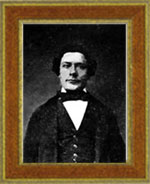Peter Jensen served a mission in Denmark for the Church of Jesus Christ of
Latter-Day Saints. He came to America with a company of Danish emigrants in
1864, crossing the plains with ox teams. He married his wife, Bodild Jensen,
also a member of the company, when they reached Nebraska City, Nebraska.
They arrived in Salt Lake in the summer of 1864 and were about to settle
there permanently when President Brigham Young called him to go to help the
settlers in Iron County.
At an early age Peter had learned two trades that became very useful in
new home; that of a tailor and a brick maker and builder. He, therefore, was
very busy in the new community of Parowan. He directed and helped make the
brick or adobe and constructed many of those early homes. Some are still
standing today. It was after the day's work was done that he did his tailoring,
sitting cross-legged on a table by the light of a coal lamp, he worked long
into the night. Mrs. Amelia Topham of Parowan (a cousin) said the "Uncle
Pete" made her husband's wedding suit and it was beautiful.
Peter and his good wife suffered many of the severe hardships of early
pioneer life. Eight children were born to them. He took an active part in
church and community life. He also served as Justice of the Peace. When their
eight child was only months old, Peter's beloved wife was stricken with an
incurable sickness that caused her to be bed ridden until her death in 1882.
The children, in later years, remembered their last Christmas dinner with
their mother. The table was pulled close to her bedside and they all enjoyed
rice pudding made by their father. The eldest daughter with the help of the father
and other older brothers and sisters cared for baby Wilford and kept the
household going.
After the loss of his wife, Peter had a desire to take his family and journey
to Richfield where two of his sisters and their families, as well as a number
of cousins, had settled since coming from Denmark. He hoped for their support
in caring for his young family. He packed as many of their belongings as possible
into the wagon, hitched the two faithful horses to the load and journeyed up
Little Creek Canyon, over the mountain and along the route where Highway 89 is
now, to Richfield. It was a three or four day journey and they slept near the
haystacks of farmers along the way. Peter and family were received with genuine
and loving hospitality by his people in Richfield. He found many of his relatives
and friends who had come from Denmark to make new homes in Utah. He soon had a
comfortable house for his family and kept busy wherever he could find work. It
was not easy to provide the meager necessities for his family. He had a strong
desire to keep his children together as long as possible and did all he could to
keep them in school, and encouraged them to keep busy when work was available
It wasn't long until his three older children, Anders, Peter and Heber married
and established homes of their own. In the late 1880's or early 1890's when the
mining boom opened up in western Utah and eastern Nevada, freighting outfits were
needed to haul supplies to the mines from Beaver, Milford as well as other points.
Peter found that a contract was available for a party with a 4-horse team of strong
horses, a wagon, and a dependable driver. Furthermore, there was a demand for eating
and rooming houses in Beaver for travel salesmen known as "drummers".
Even though it would mean moving from Richfield to Beaver, this was a perfect offer
for the family. He had the horses and wagon. A 14 year old son, Niels, was a dependable
driver or teamster. The two teenage daughters, "Sophie" and "Tean", who had become
excellent cooks were excited and happy to be part of the new venture. So the contract
was signed and the family moved to Beaver.
The house became a boarding and lodging place for the weary "drummers", as well as
headquarters for the freight outfits, and a home for father Peter and his family of
growing children.
The business prospered and gave satisfactory service to the community; but after
several years the freighting business began to be unprofitable as conditions at the
mines no longer demanded the same service.
Unexpectedly, a new opportunity came about just when it was needed; a contract
was offered to operate a mail and passenger service from Richfield, Utah to Ely, Nevada
and St. George, Utah. Peter was awarded this contract, and in short time he was back
in Richfield, ready for business. The same kind of service was offered except, for a
brand new white top rig, with young Niels in charge.
Peter Jensen was the successful proprietor of the Jensen House until about 1905 when
he sold the entire business and invested in some unimproved land north-west of town.
After several years of hard labor, he was the proud owner of a beautiful fruit orchard
in the foothills just above his crop land. Severe attacks of asthma made it hard for him
to continue this kind of work, so he sold out and retired in 1908 and spent his remaining
years with his married children in Idaho, Salt Lake City, Beaver, and Richfield. He was
an ardent reader (never wore glasses) and loved to walk.
Peter died at the home of his eldest daughter in Richfield, May 3, 1914 at the age of
seventy six.


